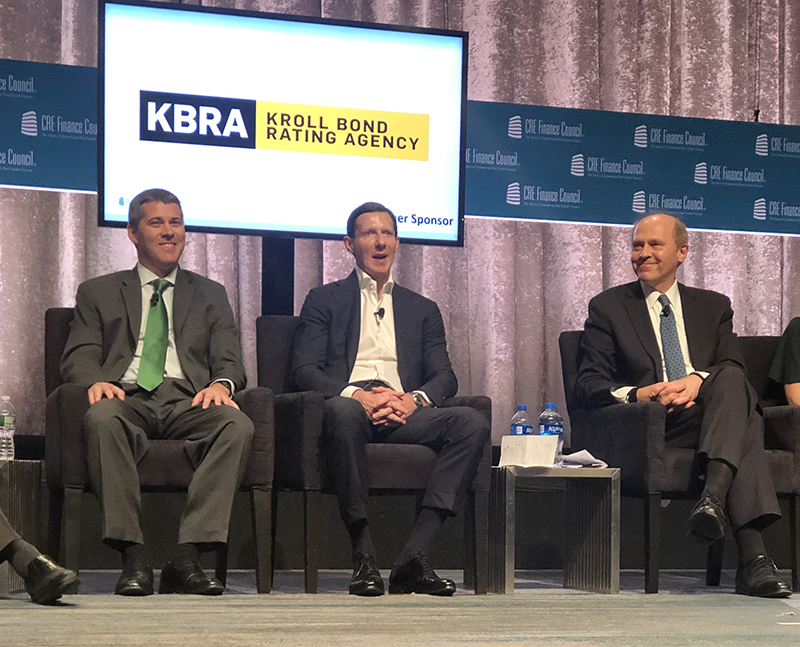Maturation of CRE CLO Market Drives Robust Issuance in 2019

- Commercial real estate collateralized loan obligation (CRE CLO) issuance so far in 2019 has exceeded expectations.
- The CRE CLO market has matured in the post-crisis era, with issuers becoming more comfortable with managed deals.
- Issuances post-crisis are significantly different than those pre-crisis, panelists noted at the CREFC's Second Annual CRE CLO Conference.
Commercial real estate collateralized loan obligations (CRE CLOs) continue to be an attractive and stable financing tool for lenders. Throughout the post-crisis era, the CRE CLO marketplace has matured, with 25 issuers now in the space and 2019 issuance set to exceed expectations. Volume totaled just under $13 billion as of August 2019, with the potential for total annual issuance to surpass $19 billion. Panelists discussed this and other trends at the recent CRE Finance Council Second Annual CRE CLO conference in New York City. Many industry players expected issuance to remain relatively flat in 2019. However, volume through August represents nearly a 42% increase from the same period in 2018, when volume totaled roughly $9.2 billion.
Shift From Static to Managed Deals
A primary change reflecting the maturation of the CRE CLO market has been the shift from static to managed deals. Post-crisis, issuers have primarily focused on static transactions. Static deals don’t have reinvestment periods, are shorter in duration, and investors know the full the portfolio of loans at closing. However, over the last few years, more issuers are pursuing managed deals. In these deals, the CLO manager actively manages the collection of loans for a fixed reinvestment period and can buy and sell loans in the pool.
There has been a “decided shift away from static issuances as being the norm to more managed issuance” due to the type of collateral in these deals and the efficiency of managed structures, noted panelist Kunal Singh of J.P. Morgan. He pointed out that the market has already seen 11 issuers issue a managed deal. While two-thirds or more of transactions used to be static, Singh notes that managed issuances will likely make up 65% of the market by year-end 2019.
Arbor was one of the first lenders to issue a managed deal, completing its first CRE CLO in 2012. Its 13 subsequent CRE CLOs have also been managed transactions, said panelist Gene Kilgore, Executive Vice President, Structured Securitization, at Arbor Realty Trust.
“The managed CRE CLO market started in 2012, but it took a while to gain real traction,” Kilgore said. “It’s only in the last two to three years that the market has taken off to a large degree.”
Pre-Crisis Versus Post-Crisis CRE CLO Market
The CRE CLOs of today are much different than pre-crisis. Kilgore noted that deals today are much lower leverage, both in the structure and in the collateral, making them more attractive to investors. The collateral today is virtually all first-mortgage loans, while almost all pre-crisis deals had subordinate loans.
On the structure side, a lot of new features have been added into post-crisis deals that show the maturation of the market. Reinvestment periods on managed deals are nearly half of what they were pre-crisis, Kilgore said. Most deals pre-crisis had five-year reinvestment periods, while today they are 24 to 36 months.
Another significant difference is that CLO managers have equity in the vehicles. Because CRE CLOs are an integral part of financing originators’ business, they have a reason to be invested in the deal’s performance.
“Given the structure, given the leverage of the collateral and the structure, and given the relative lack of cushion at least in a lot of deals, I think you will see a lot of good management behavior,” Kilgore said.
The investor base for CRE CLOs are also more sophisticated than they were pre-crisis, Kilgore noted.
“They understand the structures and ask good questions. If they aren’t comfortable, they will take a pass, so I think the market is balanced,” he concluded. “You see a lot of good behavior on the parts of dealers and issuers. They’re putting themselves in the shoes of the buyer base and determining what is necessary to get them comfortable with a managed deal. As a result of those things, we’ve seen far greater acceptance of managed deals.”

